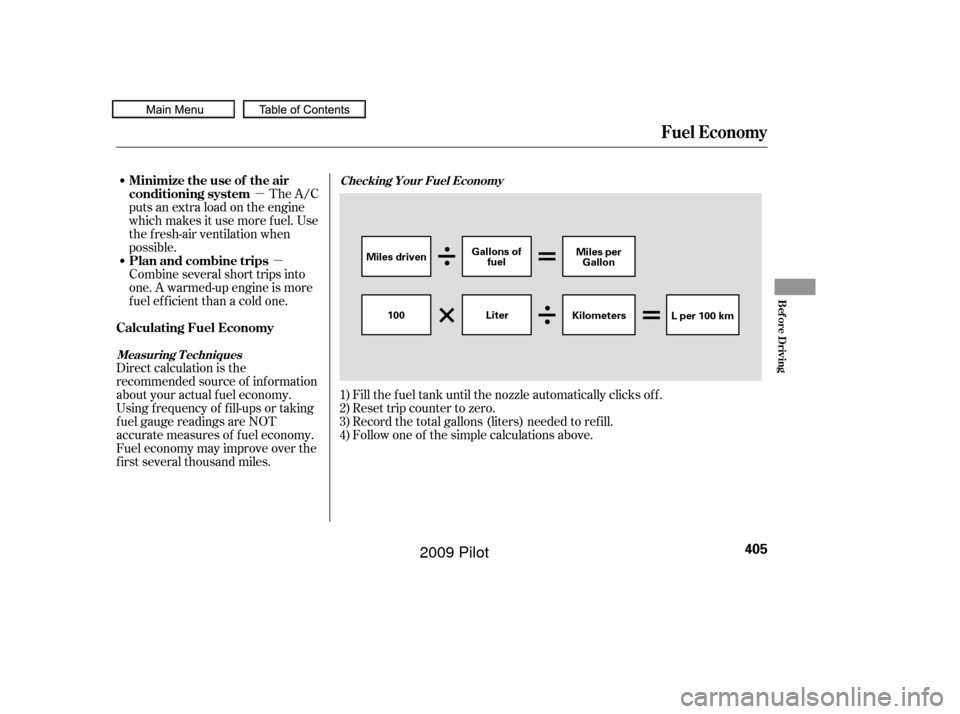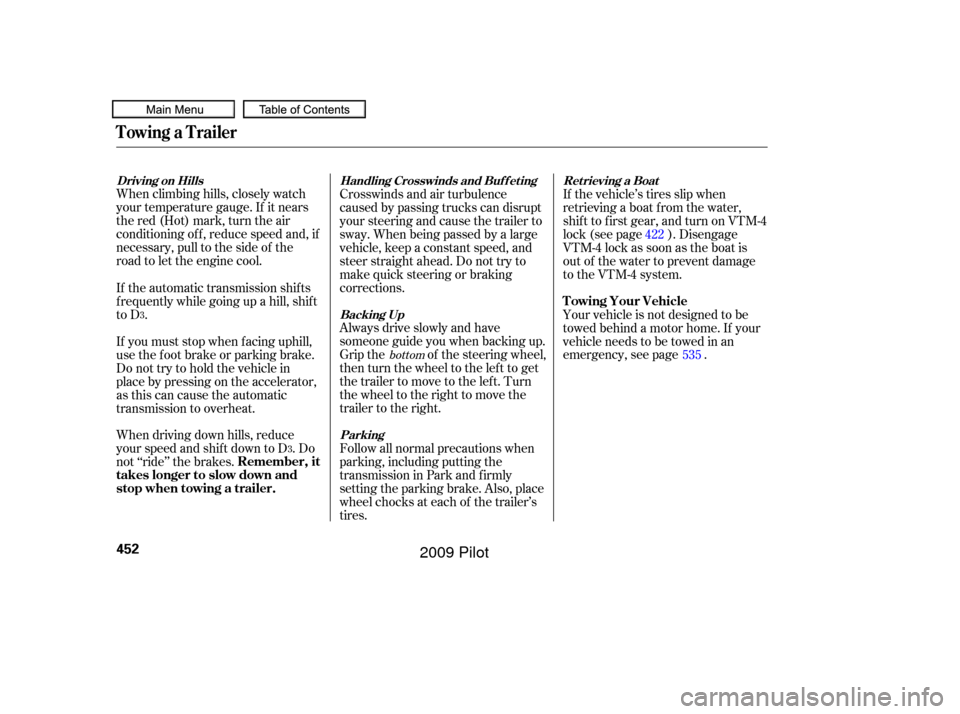Page 409 of 578

�µ�µ
Fill the f uel tank until the nozzle automatically clicks of f .
Reset trip counter to zero.
Record the total gallons (liters) needed to ref ill.
Follow one of the simple calculations above.
The A/C
puts an extra load on the engine
which makes it use more f uel. Use
the f resh-air ventilation when
possible.
Combine several short trips into
one. A warmed-up engine is more
f uel ef f icient than a cold one.
Direct calculation is the
recommended source of inf ormation
about your actual f uel economy.
Using f requency of f ill-ups or taking
f uel gauge readings are NOT
accurate measures of f uel economy.
Fuel economy may improve over the
f irst several thousand miles. 1)
2)
3)
4)
Checking Your Fuel Economy
Measuring T echniquesMinimize the use of the air
conditioning system
Plan and combine trips
Calculating Fuel Economy
Fuel Economy
Bef ore Driving
405
Miles driven Gallons of
fuel Miles per
Gallon
100 KilometersL per 100 km
Liter
�����—�����—�
���y�
������
������y���
�(�/���������y�����
���y
2009 Pilot
Page 456 of 578

When climbing hills, closely watch
your temperature gauge. If it nears
the red (Hot) mark, turn the air
conditioning of f , reduce speed and, if
necessary, pull to the side of the
road to let the engine cool.Always drive slowly and have
someone guide you when backing up.
Grip the of the steering wheel,
then turn the wheel to the left to get
the trailer to move to the lef t. Turn
the wheel to the right to move the
trailer to the right.
Follow all normal precautions when
parking, including putting the
transmission in Park and f irmly
setting the parking brake. Also, place
wheel chocks at each of the trailer’s
tires. Crosswinds and air turbulence
caused by passing trucks can disrupt
your steering and cause the trailer to
sway. When being passed by a large
vehicle, keep a constant speed, and
steer straight ahead. Do not try to
make quick steering or braking
corrections.If the vehicle’s tires slip when
retrieving a boat f rom the water,
shif t to f irst gear, and turn on VTM-4
lock (see page ). Disengage
VTM-4 lock as soon as the boat is
out of the water to prevent damage
to the VTM-4 system.
Your vehicle is not designed to be
towed behind a motor home. If your
vehicle needs to be towed in an
emergency, see page .
If the automatic transmission shif ts
f requently while going up a hill, shif t
to D .
When driving down hills, reduce
your speed and shif t down to D . Do
not ‘‘ride’’ the brakes. If you must stop when f acing uphill,
use the f oot brake or parking brake.
Do not try to hold the vehicle in
placebypressingontheaccelerator,
as this can cause the automatic
transmission to overheat.
535
422
bottom
3
3
Driving on Hills Handling Crosswinds and Buf f et ing
Backing UpParking Ret rieving a Boat
Towing a Trailer
Towing Your Vehicle
Remember, it
takes longer to slow down and
stop when towing a trailer.
452
�����—�����—�
���y�
�������������y���
�(�/���������y���������y
2009 Pilot
Page 546 of 578

�µ�µ�Î
�Î
�Î�Î
�Î
�Î�Î
�Î �Î
�Î
�Î
�Î�Î
�Î
Specif ications
542
Seating Capacities Air Conditioning Dimensions
Capacities
Weights 1.98 US gal (7.5
)
2.48 US gal (9.4)
4.5 US qt (4.3
)
4.2 US qt (4.0
)
5.3 US qt (5.0
)
190.9 in (4,850 mm)
78.5 in (1,995 mm)
70.9 in (1,802 mm)
21.00 US gal (79.5
)
Total
Front
Second
Third 3 3
2
8
Refrigerant type
Charge quantity
Lubricant type
ND-OIL8
21.2 22.9 oz (600 650 g) HFC-134a (R-134a)
The GCWR must be reduced 2 percent for every 1,000 feet (305
meters) of elevation. See the tire information label atta-
ched to the driver’s doorjamb.
8,466 lbs (3,840 kg)
Length
Width
Height
Wheelbase
Track
67.5 in (1,715 mm) 67.7 in (1,720 mm)
109.3 in (2,775 mm)
Excluding the oil remaining in the engine
0.214 US gal (0.81
)
Including the coolant in the reserve tank and that remaining in the
engine
Reserve tank capacity: 4.2 US qt (4.0
)
Fuel tank
Engine
coolant
Engine oil
Automatic
transmission
fluid
Rear
differential
fluid (4WD)
Transfer
assembly
fluid (4WD)
Windshield
washer
reservoir
6.9 US qt (6.5)
72.7 in (1,846 mm)
9,579 lbs (4,345 kg)
3.6 US qt (3.4
)
8.6 US qt (8.1)
3.6 US qt (3.4)
8.6 US qt (8.1)
2.79 US qt (2.64)
3.01 US qt (2.85)
0.45 US qt (0.43
)
0.48 US qt (0.45)
Gross vehicle weight rating
Gross combined weight
rating (GCWR) Approx.
Front
Rear
1:
2:U.S. vehicles
Canadian
vehicles
1 :
2 : Except U.S. LX models
U.S. LX models
2WD models
1:
2:
3: 4WDmodels 2WD
4WDChange
Total
Change
Including
filter
Without
filter
Total
Change
Total
Change
Total
Change
Total
Change
Total
1 1
2
2
31
2
�����—�����—�����y�
�������������y���
�(�/���������y���������y
2009 Pilot
Page 566 of 578

CONT INUED
BatteryCharging System ...........................
Indicator .68, 525
............................
Jump Starting .521
..............................
Maintenance .508 ............................
Specif ications .543
..............................
Bef ore Driving .397
....................................
Belts,Seat .8,20
.........................
Beverage Holders .179
.......
Bluetooth
HandsFreeLink. 360
..................................
Booster Seats .56
Brakes ...........
Anti-lock System (ABS) . 433
.............
Break-in, New Linings . 398
............
Bulb Replacement . 490,492
...........................................
Fluid .485
.......................................
Parking .167
.................
System Indicator . 69,527
........................
Wear Indicators .433
.............................
Braking System .432
.................
Break-in, New Vehicle . 398
Brightness Control, ...............................
Instruments .129
................................................
AAC .298
...
Accessories and Modif ications . 406
ACCESSORY (Ignition Key .....................................
Position) .135
............
Accessory Power Sockets . 184
...........................
AC Power Outlet .185
................
Active Head Restraints . 156
....................
Additives, Engine Oil . 477
...........................
Advanced Airbags .29
...............................
Airbag (SRS) .9, 24
..........
Airbag System Components . 24
......
Air Conditioning System . 190,197
.............
Rear A/C Control . 195,202
.......................
Air Outlets (Vents) .204
.......................
Air Pressure, Tires .500
......................................
Antif reeze .479
Anti-lock Brakes (ABS) ....................
Indicator Light .70, 434
...................................
Operation .433
..............
Anti-thef t, Audio System . 311
Anti-thef t Steering Column ............................................
Lock .135
........
Audio System . 206,208,224,250 Auto Control Mode, Starting
........................................
Engine .415
............................
Auto Door Lock .114
...
Auto Door Locking/Unlocking . 137
.........................
Auto Door Unlock .115
..........
Automatic Climate Control . 197
.......................
Automatic Lighting .125
...
Automatic Seat Belt Tensioners . 22
.............
Automatic Speed Control . 348
..............
Automatic Transmission . 417
..........................
Capacity, Fluid .542
...............
Checking Fluid Level . 482
.......................................
Shif ting .417
Shif t Lever Position ...............................
Indicators .417
................
Shif t Lever Positions . 418
....................
Shif t Lock Release . 420
......................
Auxiliary Input Jack .308
Index
A
B
INDEX
I
�����—�����—�����y�
�����������
�y���
�(�/���������y���������y
2009 Pilot